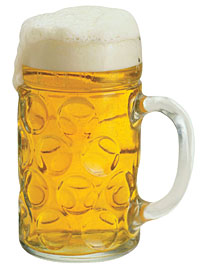 |
But things weren't always this way. In the beer-scarce 1980s, when there was only one local brand of beer available (Star) you would be hard-pressed to find a beer that hadn't gone flat.
Fresh beers are now abundantly available. Most restaurants offer as many varieties of beer as dishes. But its prevalence isn't its only plus point. It's also cheaper than wine, a popular alternative. So, unless you win a handsome lottery forget wine and buy beer.
Long gone are the days when parties modestly offered little more than small talk and musical chairs, or perhaps among braver crowds, charades. With booze, people party differently. Or maybe the word is: raucously.
 |
Nirvana Chaudhary of Chaudhary Group is upbeat about the increasing consumption of beer, and says there is great domestic growth potential as well as a market for Nepali beers abroad.
"Nepal Ice is the first Nepali beer to reach international markets like UK, Hong Kong and Japan," says Chaudhary.
Within Nepal, Chaudhary's target group are party-going youngsters and young professionals who look forward to coming home to a long, tall glass of chilled beer.
Gaining ground in a market dominated by locally made beer is the German-based Lowenbrau. But it is an uphill task, admits Suranjan De' of Pepsi Nepal, which also markets Lowenbrau in Nepal. "Lowenbrau is becoming widely accepted in Nepal too, but it is difficult to move in the same velocity as the other companies," De told Nepali Times.
Sabhyata Timsina
Old wine in a new market
 |
When once a bottle of Barsac would be carelessly stored alongside a packet of alu chips, in many kitchens wine now has a cabinet to itself.
Wine wholesalers in Kathmandu say the bottles are flying off the shelves. Wine importer Akhil K Chapagain of Akhil Trading Concern says wine has caught on in a big way. "Not a single celebration in Kathmandu is complete without wine," says Chapagain.
Amit Agrawal of Greenline Centre agrees. Agrawal and Chapagain both note that wine consumption is going up sharply because women have become enthusiastic tipplers. "Women are our main consumers, along with youngsters," says Agrawal.
 |
Industry sources say that with 3,000 wine brands in the market, there is stiff competition in a price-sensitive market. Ashish Bista of Gorkha Brewery which also markets wines, explains: "With so many varieties available the wines compete with each other."
 |
Wine distributors are trying to change this by organising frequent wine-tasting events in collaboration with embassies of the countries from where the wines originate, like Australia, France and the United States. As more Nepalis return from studies or work abroad, they bring back a cultivated taste for wine and this is also spreading awareness.
Subeksha Poudel


